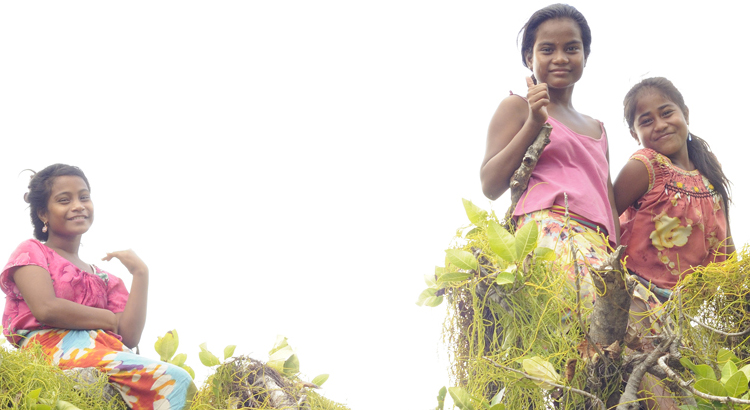
Officially we are still “tourists” and it’s weekend again. So we do the Cultural Tour to Abatao and get to know this side of the island. Abatao is the second island of North Tarawa, and the first one that can not be reached via a bridge. It is already considered an Outer Island. It is a foretaste on the other remoter islands of Kiribati.
(Written by Claudia Skodda) Unfortunately, the tides do not allow us to take a boat across the lagoon, so we’ll are picked up by a small bus and ride along the well-known road to Bonriki airport and then north crossing the adventurous bridge to Buota, the first island of North Tarawa. It is now the time of the incoming tide and the water that flows under the bridge into the lagoon is quite deep already. Children and young people use the dilapidated bridge as a diving tower, cleverly cheating past the barbed wire, which is by chances supposed to prevent exactly that. There is an exuberant atmosphere everywhere, it’s weekend, a day out.
We drive on a sand path to a small village. Here, most of the buildings are traditional and there is much more space, not every inch is used up for buildings, as we are used to from South Tarawa. We stop in front of a small Mwaneaba (assembly house). There, in various small groups, women and girls sit under the roof of leaves and are busy with various braiding. Kato, our companion, explains to us that this is just the work that everyone else is usually doing at home. But here it is demonstrated to us. “Demonstrated”. I get an uncomfortable feeling which I also recognize in the faces of the other members of the team. We did not long for these artificial situations. But now we are here and try to overcome the distance between us as tourists and them, being the demonstrated locals.
I sit down next to a woman who makes ropes of coconut straw and try it myself. Under some warm, encouraging laughter I try to extend the Coco-rope by twisting the material with my hands. It looked so easy and yet I need many attempts, until I finally succeed to some extend. My curiosity helps to break the ice. We start talking and I’m no longer a mere observer. I am fascinated by how they produce all the necessary items from the existing materials in a simple but sophisticated way, be it a watertight roof made of pandanus leaves, the ropes made of coconut straw or the most diverse types of wicker for mats with different specifications.
From the other side of the Mwaneaba I hear the cheers and the giggles around little Maira. They made her some toys out of palm leaves: a bird, a pair of glasses, a cube, a wristwatch for her arm, and a crown for her head. They tell us that the children here are not getting so much bought toys, but rather play with what is there and what is made with a lot of imagination. Maira is richly gifted and all tell us laughingly “ti a boo” (pronounced: [saboe] = Good by).
We continue to the “ferry”, which we will use to cross over to Abatao. There is a lot of traffic. On the small outrigger canoe furniture and bicycles are loaded. Unbelievable, what can be transported with it. Finally, we sit on the swinging boards, dangling with our legs in the clear water and enjoying the crossing.
After a short walk through trees and bushes, two surprises await us. We had been told we would visit a shell farm, which is exactly what we find. But this farm is not about nutrition but for a rare species of shells kept for its beauty and exported from this little place to all over the world to decorate aquariums. The smallest are no bigger than a fingernail others are bigger than a loaf of bread. They all shimmer in a variety of colourful shades from green to azure to the deepest purple.
Right next to it, a small bed of tomatoes shines, some glow red. Tomatoes are an absolute treasure here on the islands and we adults have to settle for the sight, but Maira gets a tomato presented and clearly enjoys it.
We spend the afternoon with swimming and eating in a place where we were already a few weeks ago and which comes very close to the traditional concept of a South Pacific paradise. Clear water with a white beach that leads up to a land under palm trees and breadfruit trees, where one is always surrounded by a refreshing wind. We get into conversation with Kato, also on topics beyond tourism.
At the end, she strolls with us through the adjacent village of Abatao. Again and again there are greetings: “Mauri Mauri” and short jokes and talks, you know each other.
From a treetop, we are being waved goodbye. We want to come back – and this time not as tourists.



